Access to Secondary HSR Stations in the Urban Periphery: A Generalised Cost-Based Assessment
Abstract
:1. Introduction
2. Background
- Base scenario: the current Santa Justa station only.
- Alternative scenario: two stations operating simultaneously, the current Santa Justa station and a new station—Cantaelgallo—on the outskirts of the metropolitan area.
2.1. Base Scenario: Current Station
2.2. Alternative Scenario: Two Stations
3. Methodological Framework
3.1. Data sources
3.2. Assessment of Territorial Accessibility Based on Generalised Cost Functions
3.2.1. Step 1. Travel Time and Distance Access Per Zone
3.2.2. Step 2. Modal Share Adjustment Per Zone
3.2.3. Step 3. Generalised Cost Per Zone
3.2.4. Step 4. Assignment to Station
3.3. Economic Assessment
4. Results
4.1. Accessibility in the Base Scenario: Santa Justa Station
4.2. Accessibility in the Alternative Scenario
4.2.1. Cantaelgallo Station
4.2.2. Zone Assignment to Stations and Full Alternative Scenario
4.3. Economic Analysis
5. Discussion and Conclusions
Author Contributions
Funding
Data Availability Statement
Acknowledgments
Conflicts of Interest
References
- European Commission (EC). Roadmap to a Single European Transport Area—Towards a Competitive and Resource Efficient Transport System; White Paper, COM(2011) 144 Final; European Commission: Brussels, Belgium, 2011.
- European Court of Auditors. Special Report Nº 19/2018: A European High-Speed Rail Network: Not a Reality but an Ineffective Patchwork; European Union: Luxemburg, 2018.
- Beria, P.; Grimaldi, R.; Albalate, D.; Bel, G. Delusions of success: Costs and demand of high-speed rail in Italy and Spain. Transp. Policy 2018, 68, 63–79. [Google Scholar] [CrossRef]
- Garmendia, M.; Ribalaygua, C.; Ureña, J. High speed rail: Implication for cities. Cities 2012, 29, 26–31. [Google Scholar] [CrossRef]
- Givoni, M. Development and Impact of the Modern High-Speed Train: A Review. Transp. Rev. 2006, 26, 593–611. [Google Scholar] [CrossRef]
- Jacobs-Crisioni, C.; Silva, F.E.; Lavalle, C.; Baranzelli, C.; Barbosa, A.; Perpiña Castillo, C. Accessibility and territorial cohesion in a case of transport infrastructure improvements with changing population distributions. Eur. Transp. Res. Rev. 2016, 8, 9. [Google Scholar] [CrossRef] [Green Version]
- Ortega, E.; López, E.; Monzón, A. Territorial cohesion impacts of high-speed rail at different planning levels. J. Transp. Geogr. 2012, 24, 130–141. [Google Scholar] [CrossRef]
- Brons, M.; Givoni, M.; Rietveld, P. Access to railway stations and its potential in increasing rail use. Transp. Res. Part A Policy Pract. 2009, 43, 136–149. [Google Scholar] [CrossRef]
- Givoni, M.; Banister, D. Speed: The less important element of the High-Speed Train. J. Transp. Geogr. 2012, 22, 306–307. [Google Scholar] [CrossRef]
- Sung, H.; Choi, K.; Lee, S.; Cheon, S. Exploring the impacts of land use by service coverage and station-level accessibility on rail transit ridership. J. Transp. Geogr. 2014, 36, 134–140. [Google Scholar] [CrossRef]
- Monzón, A.; Ortega, E.; López, E. Efficiency and spatial equity impacts of high-speed rail extensions in urban areas. Cities 2013, 30, 18–30. [Google Scholar] [CrossRef] [Green Version]
- Moyano, A.; Moya-Gómez, B.; Gutiérrez, J. Access and egress times to high-speed rail stations: A spatiotemporal accessibility analysis. J. Transp. Geogr. 2018, 73, 84–93. [Google Scholar] [CrossRef]
- Guirao, B.; Campa, J. The construction of a HSR network using a ranking methodology to prioritise corridors. Land Use Policy 2014, 38, 290–299. [Google Scholar] [CrossRef]
- Reggiani, A. Accessibility, connectivity and resilience in complex networks. In Accessibility and Transport Planning; Geurs, K., Krizek, K., Reggiani, A., Eds.; Edward Elgar: Chelttenham, UK, 2012. [Google Scholar]
- Monzón, A.; Ortega, E.; López, E. Influence of the First and Last Mile on HSR Accessibility Levels. In Accessibility, Equity and Efficiency; Geurs, K., Patuelli, R., Ponce Dentinho, T., Eds.; Edward Elgar Publishing: Chelttenham, UK, 2016; pp. 125–143. [Google Scholar]
- Sung, H.; Oh, J.-T. Transit-oriented development in a high-density city: Identifying its association with transit ridership in Seoul, Korea. Cities 2011, 28, 70–82. [Google Scholar] [CrossRef]
- Rossetti, S.; Tiboni, M.; Vetturi, D.; Zazzi, M.; Caselli, B. Measuring Pedestrian Accessibility to Public Transport in Urban Areas: A GIS-based Discretisation Approach. Eur. Transp. Trasp. Eur. 2020, 76, 1–12. [Google Scholar]
- Loo, B.P.Y.; Chen, C.; Chan, E.T.H. Rail-based transit-oriented development: Lessons from New York City and Hong Kong. Landsc. Urban Plan. 2010, 97, 202–212. [Google Scholar] [CrossRef]
- Keijer, M.J.N.; Rietveld, P. How do people get to the railway station? The Dutch experience. Transp. Plan. Technol. 2000, 23, 215–235. [Google Scholar] [CrossRef] [Green Version]
- Vickerman, R. High-speed rail and regional development: The case of intermediate stations. J. Transp. Geogr. 2015, 42, 157–165. [Google Scholar] [CrossRef]
- Martín, J.C.; Román, C.; García-Palomares, J.C.; Gutiérrez, J. Spatial analysis of the competitiveness of the high-speed train and air transport: The role of access to terminals in the Madrid–Barcelona corridor. Transp. Res. Part A Policy Pract. 2014, 69, 392–408. [Google Scholar] [CrossRef] [Green Version]
- Sánchez-Mateos, H.S.M.; Givoni, M. The accessibility impact of a new High-Speed Rail line in the UK—A preliminary analysis of winners and losers. J. Transp. Geogr. 2012, 25, 105–114. [Google Scholar] [CrossRef]
- Mohino, I.; Loukaitou-Sideris, A.; Ureña, J. Impacts of High-Speed Rail on Metropolitan Integration: An Examination of London, Madrid and Paris. Int. Plan. Stud. 2014, 19, 306–334. [Google Scholar] [CrossRef]
- Givoni, M.; Rietveld, P. Do cities deserve more railway stations? The choice of a departure railway station in a multiple-station region. J. Transp. Geogr. 2014, 36, 89–97. [Google Scholar]
- Grey, A. The Generalised Cost Dilemma. Transportation 1978, 7, 261–280. [Google Scholar] [CrossRef]
- Casello, J.M. Transit competitiveness in polycentric metropolitan regions. Transp. Res. Part A 2007, 41, 19–40. [Google Scholar] [CrossRef]
- Fadaei, M.; Cats, O. Evaluating the impacts and benefits of public transport design and operational measures. Transp. Policy 2016, 48, 105–116. [Google Scholar] [CrossRef] [Green Version]
- La Paix, L.; Geurs, K. Integration of unobserved effects in generalised transport access costs of cycling to railway stations. Eur. J. Transp. Infrastruct. Res. 2016, 16, 385–405. [Google Scholar]
- Mackie, P.; Worsley, T.; Eliasson, J. Transport appraisal revisited. Res. Transp. Econ. 2014, 47, 3–18. [Google Scholar] [CrossRef]
- Vigren, A.; Ljungberg, A. Public Transport Authorities’ use of Cost-Benefit Analysis in practice. Res. Transp. Econ. 2018, 69, 560–567. [Google Scholar] [CrossRef] [Green Version]
- Bardal, K.G. Contradictory outcomes of cost-benefit analyses—Findings from Norwegian public-investment projects. Res. Transp. Econ. 2020, 82, 100874. [Google Scholar] [CrossRef]
- Martens, K.; Di Ciommo, F. Travel time savings, accessibility gains and equity effects in cost-benefit analysis. Transp. Rev. 2017, 37, 152–169. [Google Scholar] [CrossRef]
- Zhang, W.; Nian, P.; Lyu, G. A multimodal approach to assessing accessibility of a high-speed railway station. J. Transp. Geogr. 2016, 54, 91–101. [Google Scholar] [CrossRef]
- Observatorio de la Movilidad Metropolitana (OMM). Informe OMM-2018. [2018 Annual Report]. 2020. Available online: http://www.observatoriomovilidad.es/images/stories/07_jornadas/17_jornada_17_online/INFORME_FINAL_WEB.pdf (accessed on 12 April 2021).
- AENA. Annual Report 2019. 2021. Available online: http://www.aena.es/csee/ccurl/174/519/00.Definitivo_2019.pdf (accessed on 12 April 2021).
- Observatorio del Ferrocarril en España (OFE). Informe 2019 del Observatorio del Ferrocarril en España [Spanish Railway Observatory—2019 Annual Report]. 2020. Available online: https://www.mitma.gob.es/recursos_mfom/comodin/recursos/ofe_2019_mar2021.pdf (accessed on 12 April 2021).
- Generalitat de Catalunya. Manual del Sistema d’avaluació d’inversions en transport [Transportation Investment Appraisal System Handbook]. 2020. Available online: https://territori.gencat.cat/web/.content/home/03_infraestructures_i_mobilitat/01_carreteres/SAIT/manual-SAIT-v2020-01.pdf (accessed on 12 April 2021).
- Wang, F.; Xu, Y. Estimating O–D travel time matrix by Google Maps API: Implementation, advantages, and implications. Ann. GIS 2011, 17, 199–209. [Google Scholar] [CrossRef]
- Bouscasse, H.; de Lapparent, M. Perceived comfort and values of travel time savings in the Rhône-Alpes Region. Transp. Res. Part A Policy Pract. 2019, 124, 370–387. [Google Scholar] [CrossRef]
- Wardman, M.; Chintakayala, V.; de Jong, G. Values of travel time in Europe: Review and meta-analysis. Transp. Res. Part A Policy Pract. 2016, 94, 93–111. [Google Scholar] [CrossRef]
- García-Martínez, A.; Cascajo, R.; Jara-Díaz, S.R.; Chowdhury, S.; Monzon, A. Transfer penalties in multimodal public transport networks. Transp. Res. Part A Policy Pract. 2018, 114, 52–66. [Google Scholar] [CrossRef]
- European Commission (EC). Guide to Cost-Benefit Analysis of Investment Projects. Economic appraisal tool for Cohesion Policy 2014–2020; Publications Office of the European Union: Luxembourg, 2014. [CrossRef]
- Ministerio de Fomento. Fomento Somete a Información Pública el Proyecto de la Nueva Estación de alta Velocidad de Villena (Alicante) [Press Release]. 2011. Available online: https://www.mitma.gob.es/recursos_mfom/11021902.pdf (accessed on 12 April 2021).
- Ministerio de Fomento. Fomento Adjudica el Proyecto de Integración del Ferrocarril en Palencia. [Press Release]. 2011. Available online: https://www.fomento.gob.es/NR/rdonlyres/657957E7-F5D5-4ABF-B1AF-35C7E3EEAD2A/106920/11102502.pdf (accessed on 12 April 2021).
- Observatoire de la Mobilité en Île-de-France (OMNIL). La Fréquentation des Grandes Gares Franciliennes. [Ridership at Major Parisian Railway Stations]. 2015. Available online: http://www.driea.ile-de-france.developpement-durable.gouv.fr/IMG/pdf/La_frequentation_des_grandes_gares_parisiennes.pdf (accessed on 12 April 2021).
- SNCF. Fréquentation en Gares [Ridership at Stations] [Database]. 2021. Available online: https://ressources.data.sncf.com/explore/dataset/frequentation-gares (accessed on 12 April 2021).
- Desmaris, C.; Croccolo, F. The HSR competition in Italy: How are the regulatory design and practices concerned? Res. Transp. Econ. 2018, 69, 290–299. [Google Scholar] [CrossRef] [Green Version]
- Transit Cooperative Research Program (TCRP). Report 78: Estimating the Benefits and Cost of Public Transit Projects: A Guidebook for Practitioners; Transportation Research Board of the National Academies: Washington, DC, USA, 2002. [Google Scholar]
- Jover, J.; Díaz-Parra, I. Gentrification, transnational gentrification and touristification in Seville, Spain. Urban Stud. 2020, 57, 3044–3059. [Google Scholar] [CrossRef]
- Cachia, R.; Maya Jariego, I. Mobility types, transnational ties and personal networks in four highly skilled immigrant communities in Seville (Spain). Soc. Netw. 2018, 53, 111–124. [Google Scholar] [CrossRef] [Green Version]
- Christodoulou, A.; Christidis, P. Evaluating congestion in urban areas: The case of Seville. Res. Transp. Bus. Manag. 2020, 39, 100577. [Google Scholar] [CrossRef]
- Awad-Núñez, S.; Julio, R.; Gomez, J.; Moya-Gómez, B.; Sastre, J. Post-COVID-19 travel behaviour patterns: Impact on the willingness to pay of users of public transport and shared mobility services in Spain. Eur. Transp. Res. Rev. 2021, 13, 20. [Google Scholar] [CrossRef]
- Young, M.; Blainey, S. Railway station choice modelling: A review of methods and evidence. Transp. Rev. 2018, 38, 232–251. [Google Scholar] [CrossRef] [Green Version]
- Zhen, F.; Cao, X.; Tang, J. The role of access and egress in passenger overall satisfaction with high speed rail. Transportation 2019, 46, 2137–2150. [Google Scholar] [CrossRef]
- Cascetta, E.; Coppola, P. Assessment of schedule-based and frequency-based assignment models for strategic and operational planning of high-speed rail services. Transp. Res. Part A 2016, 84, 93–108. [Google Scholar] [CrossRef]
- Repolho, H.M.; Church, R.L.; Antunes, A.P. Optimizing station location and fleet composition for a high-speed rail line. Transp. Res. Part E 2016, 93, 437–452. [Google Scholar] [CrossRef]
- European Commission (EC). Sustainable and Smart Mobility Strategy—Putting European Transport on Track for the Future; COM(2020) 789 Final; European Commission: Brussels, Belgium, 2020.
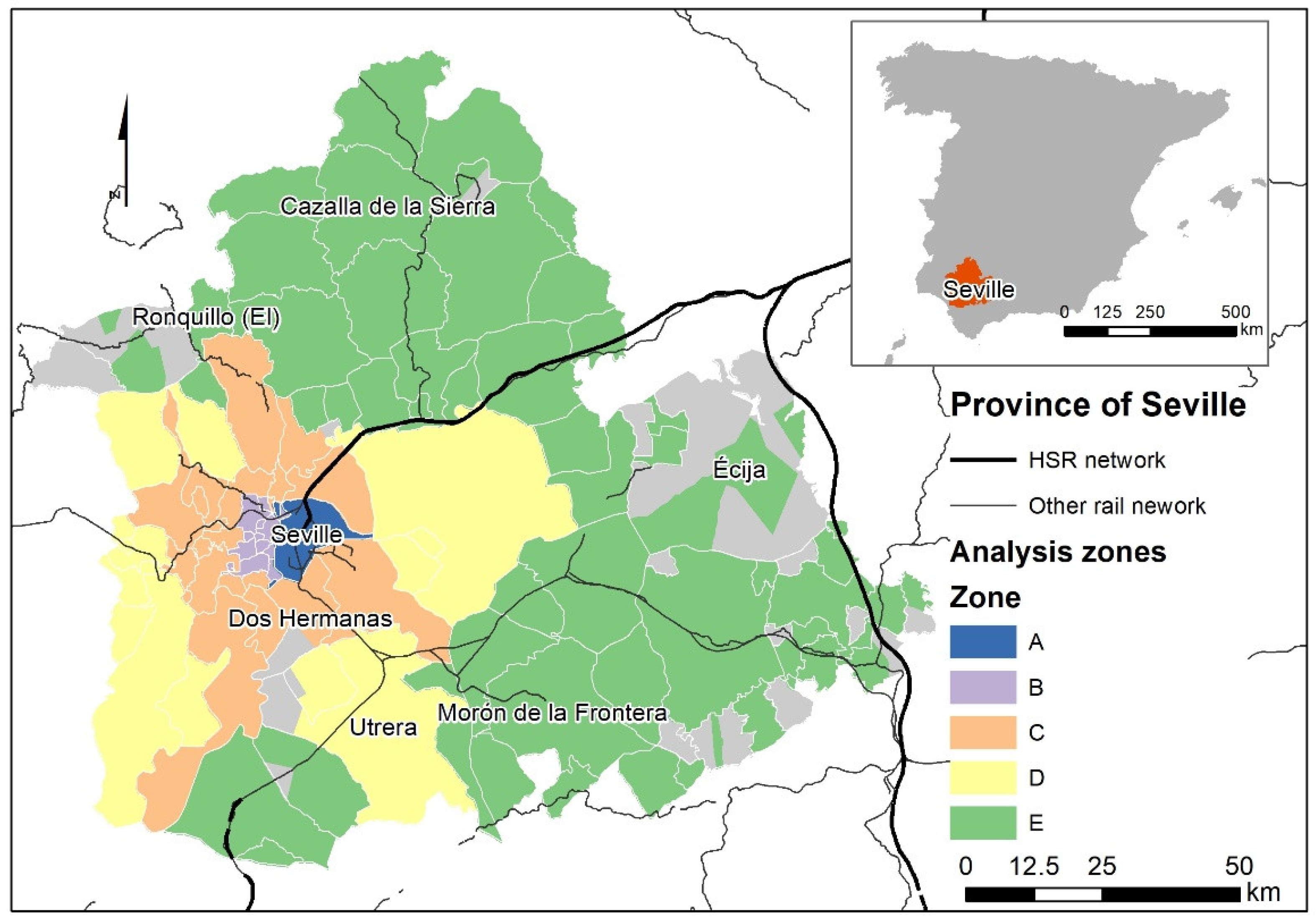
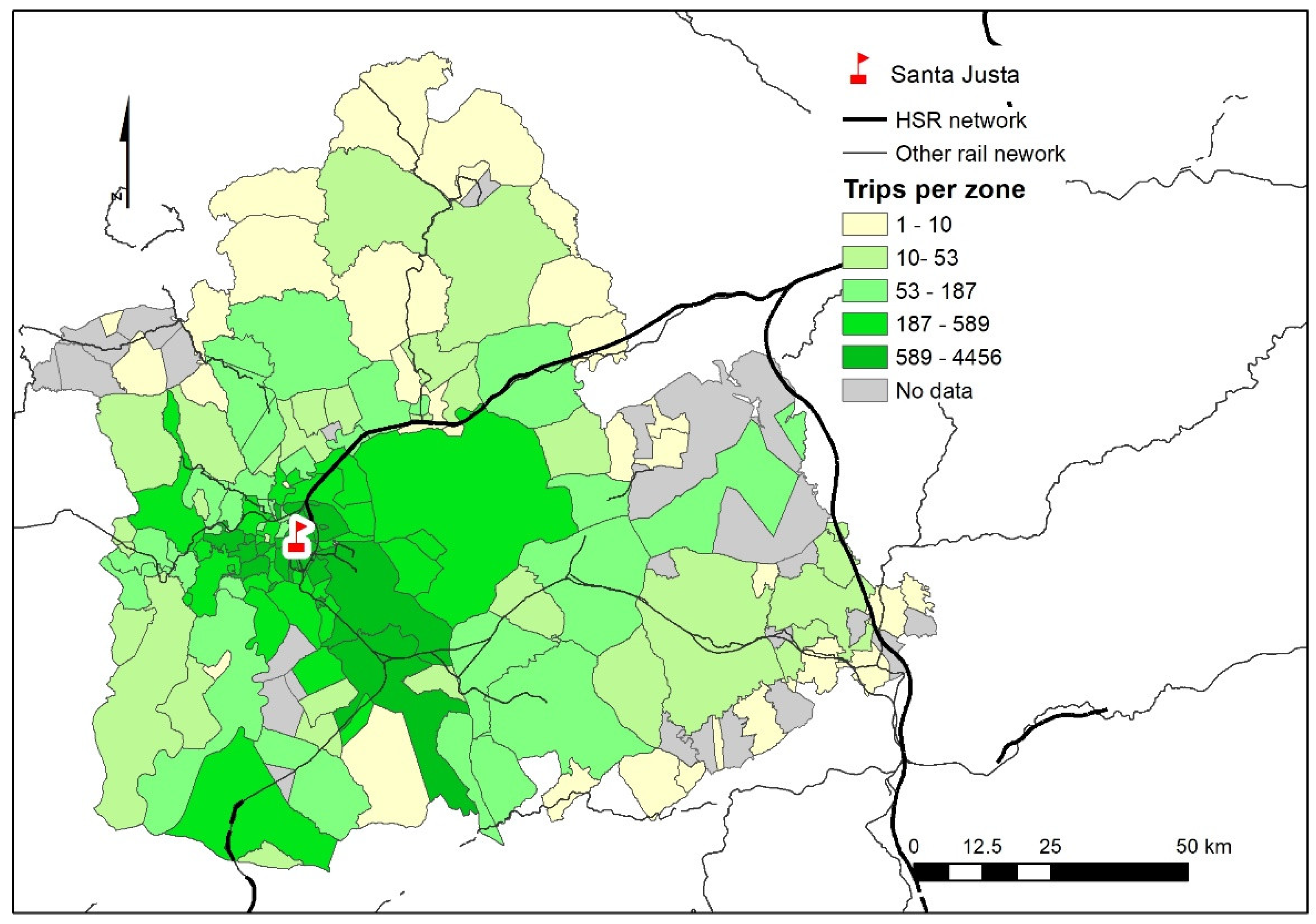

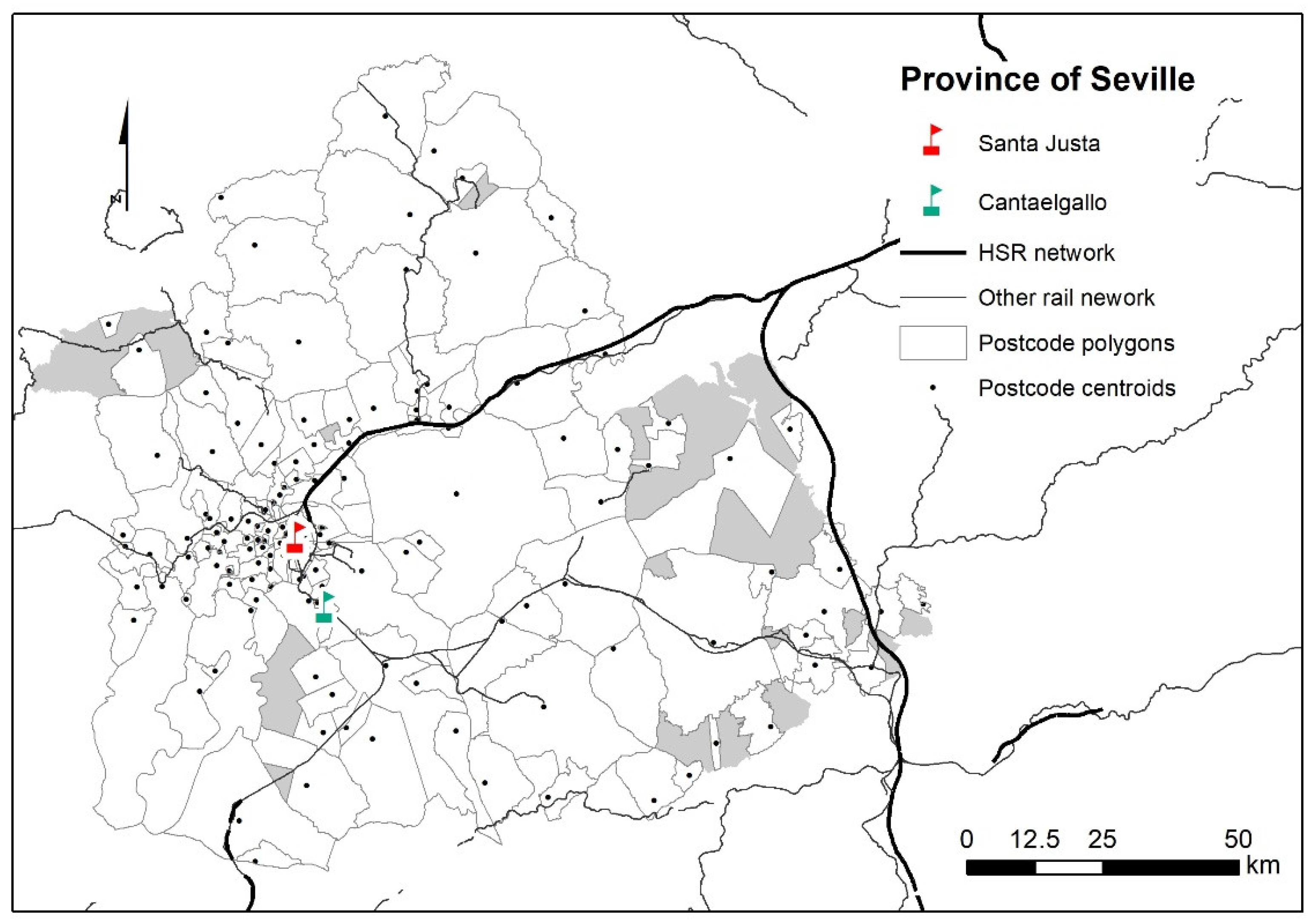
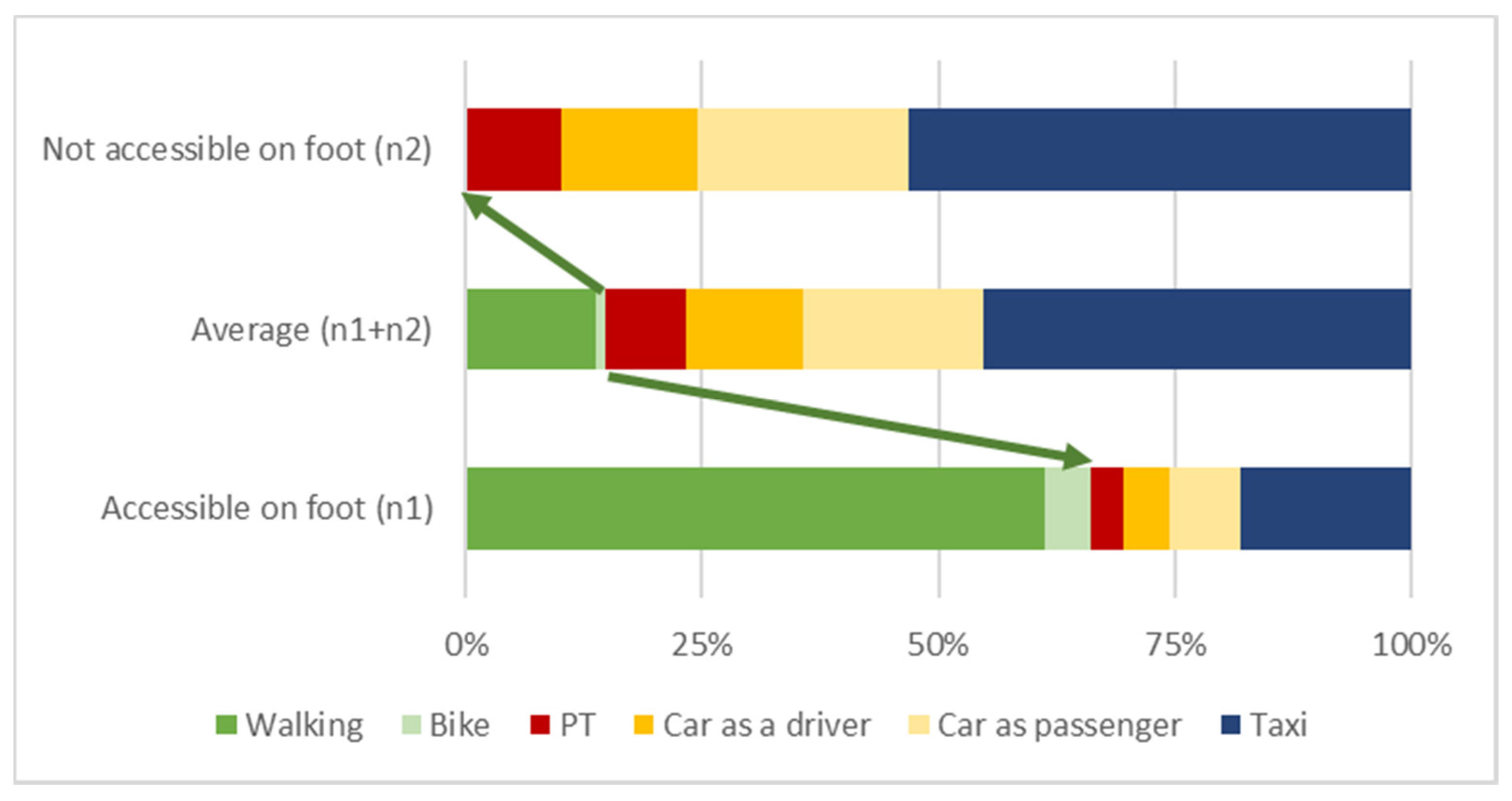
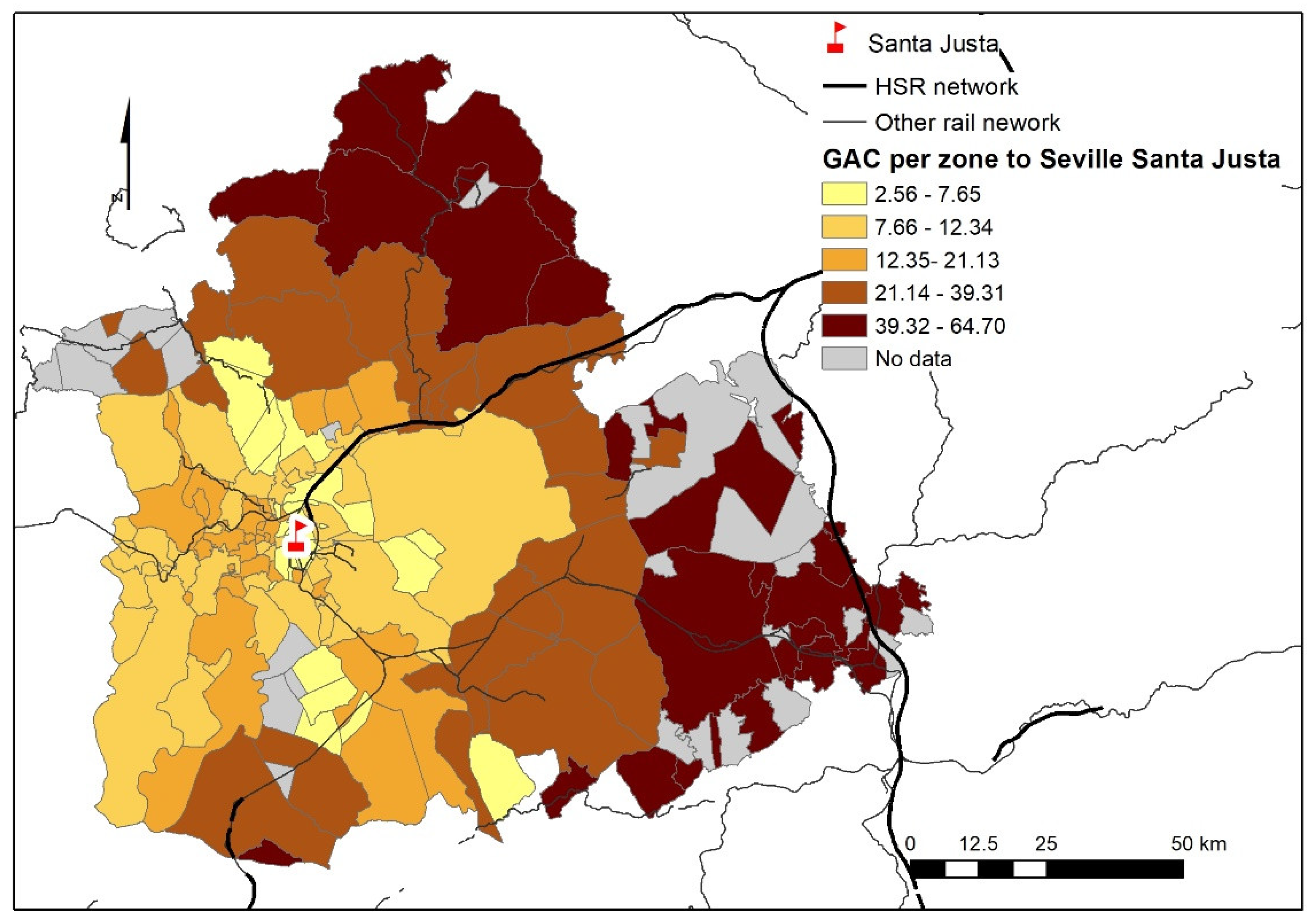
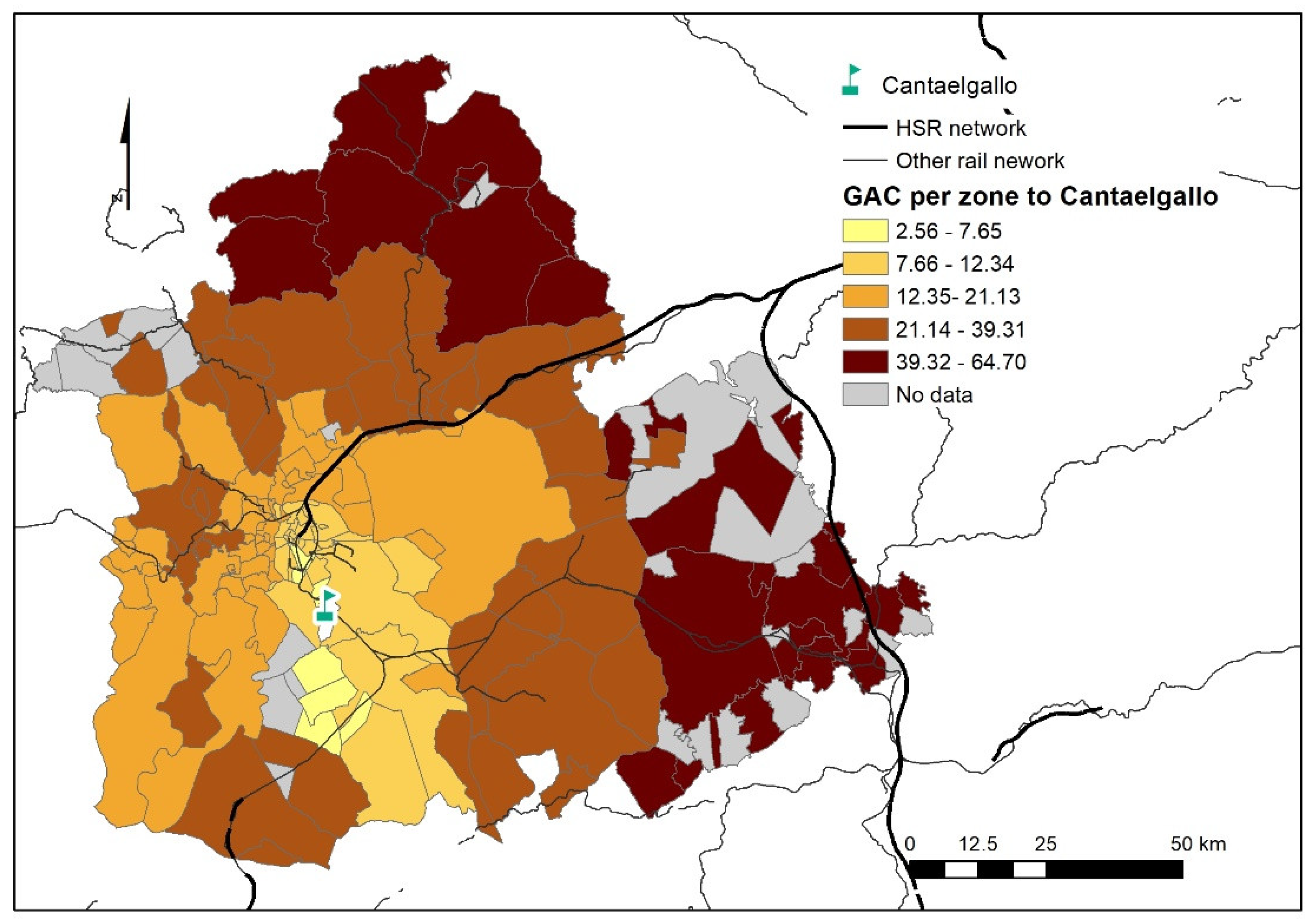
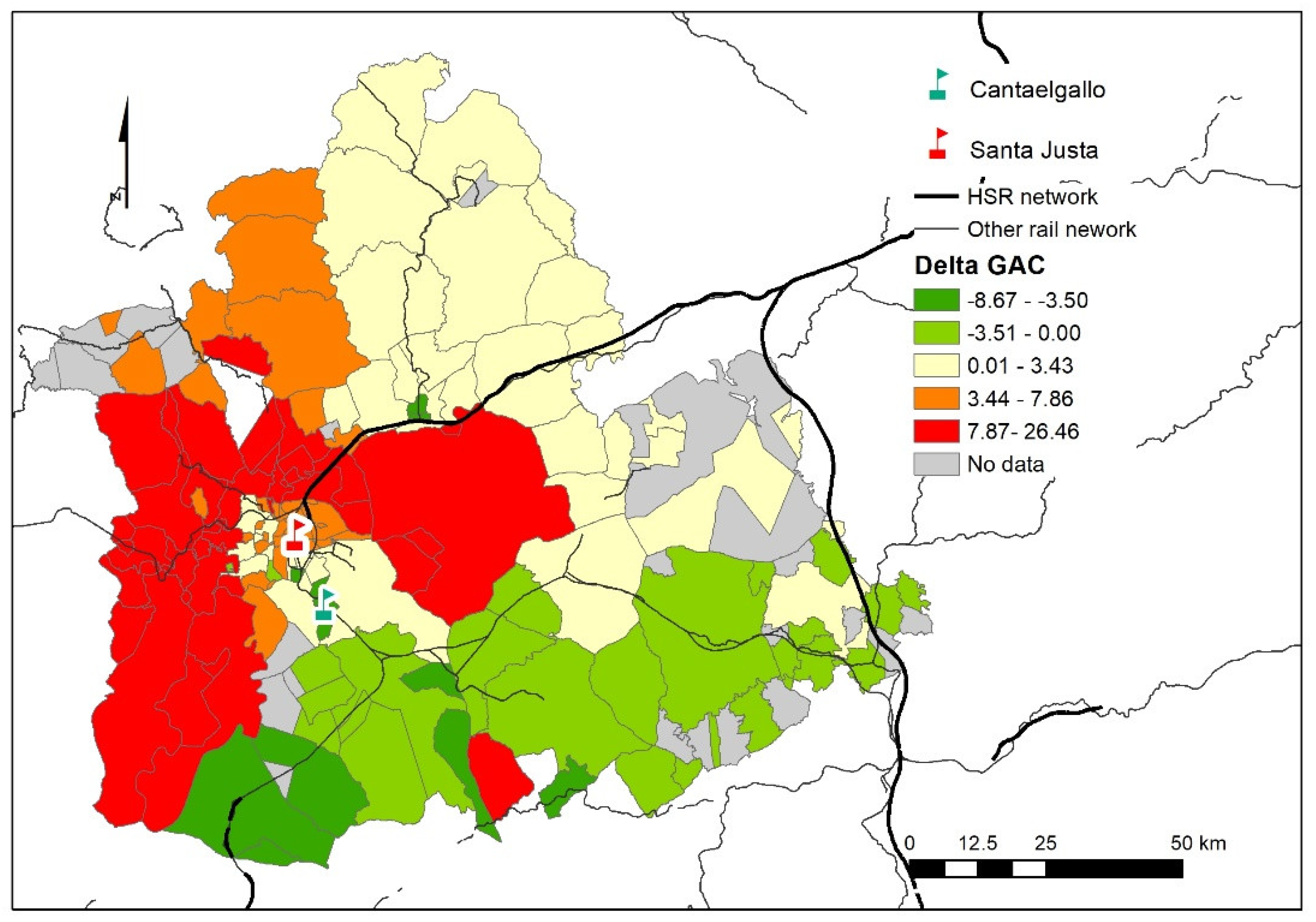
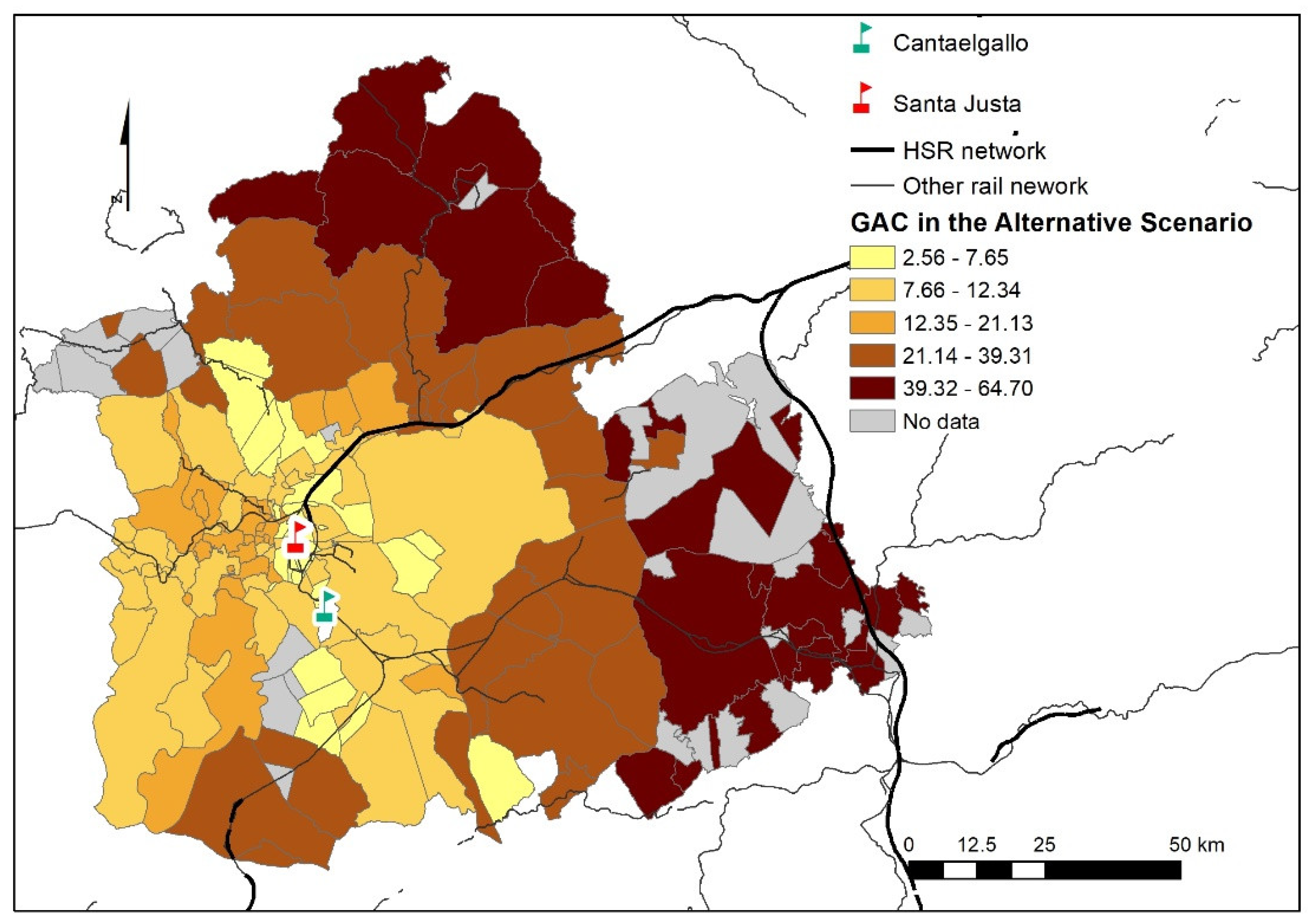
| Mode | Direct Cost (C) | tW1 | tW2 | tP |
|---|---|---|---|---|
| Walking | 0 | 0 | 0 | 0 |
| Taxi | 1.37 + 0.94d | 5 | 2 | 0 |
| Car (parking lot) | 0.29d + 22 | 5 | 2 | 2 |
| Car (free parking) | 0.29d | 5 | 5 | 5 |
| Car (as passenger) | 0 | 5 | 0 | 0 |
| Public transport | PTA fares 1 | Google API 2 | 2 | 0 |
| Purpose | % Travellers | Value of Time (€/h) |
|---|---|---|
| Work or study | 23.2% | 7.48 |
| Leisure or tourism | 38.6% | 5.10 |
| Shopping | 0.4% | 6.40 |
| Personal business (e.g., medical) | 5.6% | 10.83 |
| Multipurpose | 32.2% | 7.45 |
| Ring | Passengers (% of Total) | Seville—Santa Justa (Base Scenario) | Cantaelgallo | Both Stations (Alternative Scenario) |
|---|---|---|---|---|
| A | 64.2% | 6.26 | 9.72 | 6.04 |
| B | 12.9% | 14.32 | 15.62 | 14.29 |
| C | 15.7% | 10.27 | 17.40 | 9.78 |
| D | 4.0% | 8.77 | 14.86 | 8.46 |
| E | 3.2% | 39.64 | 37.89 | 38.15 |
| Province average | - | 8.37 | 11.48 | 8.08 |
| Total Investment (M€) | ERR (%) | NPV (M€) | IAS Ratio |
|---|---|---|---|
| 2 | 10.3% | 1.52 | 10.5 |
| 3 | 6.7% | 0.69 | 15.7 |
| 4 | 4.7% | −0.15 | 20.9 |
| 5 | 3.4% | −0.99 | 26.2 |
| 6 | 2.5% | −1.83 | 31.4 |
| 7 | 1.8% | −2.66 | 36.6 |
| 8 | 1.2% | −3.50 | 41.9 |
| 9 | 0.8% | −4.34 | 47.1 |
| 10 | 0.4% | −5.17 | 52.3 |
Publisher’s Note: MDPI stays neutral with regard to jurisdictional claims in published maps and institutional affiliations. |
© 2021 by the authors. Licensee MDPI, Basel, Switzerland. This article is an open access article distributed under the terms and conditions of the Creative Commons Attribution (CC BY) license (https://creativecommons.org/licenses/by/4.0/).
Share and Cite
Romero, C.; Zamorano, C.; Ortega, E.; Martín, B. Access to Secondary HSR Stations in the Urban Periphery: A Generalised Cost-Based Assessment. Sustainability 2021, 13, 12286. https://doi.org/10.3390/su132112286
Romero C, Zamorano C, Ortega E, Martín B. Access to Secondary HSR Stations in the Urban Periphery: A Generalised Cost-Based Assessment. Sustainability. 2021; 13(21):12286. https://doi.org/10.3390/su132112286
Chicago/Turabian StyleRomero, Carlos, Clara Zamorano, Emilio Ortega, and Belén Martín. 2021. "Access to Secondary HSR Stations in the Urban Periphery: A Generalised Cost-Based Assessment" Sustainability 13, no. 21: 12286. https://doi.org/10.3390/su132112286
APA StyleRomero, C., Zamorano, C., Ortega, E., & Martín, B. (2021). Access to Secondary HSR Stations in the Urban Periphery: A Generalised Cost-Based Assessment. Sustainability, 13(21), 12286. https://doi.org/10.3390/su132112286









